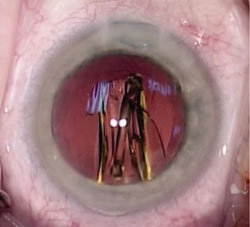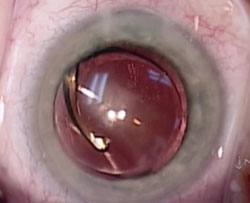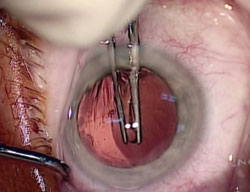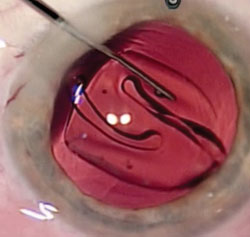Easy-release technique helpful for stuck haptic
A surgeon describes a simple procedure to release an IOL haptic from the lens optic.
 Thomas John |
Cataract surgery has continued to advance in many ways, including a shrinking wound size, reduced to no induced corneal astigmatism, advanced surgical instrumentation for lens disassembly, improved phaco handpieces, the introduction of viscoelastics (cohesive and dispersive), and the elimination of corneal sutures. In parallel, there have been continued improvements in IOL implant technology with both the standard and premium types.
Proper IOL centration and haptic placement within the capsular bag are usually the surgeon’s goal. However, occasionally when using an acrylic IOL, after delivering the IOL into the capsular bag, the surgeon may discover that the haptic has gotten stuck to the IOL optic. Although this stuck haptic is not a major surgical setback, an optimal, quick and easy technique to release the stuck haptic will be a welcome surgical maneuver for the ophthalmic surgeon.
In this column, Dr. Shen describes and illustrates a known, single-handed, quick and easy procedure to release the stuck IOL haptic that will be beneficial to all ophthalmic surgeons doing cataract surgery.
Thomas John, MD
OSN Surgical Maneuvers Editor
The stressful points during phacoemulsification cataract surgery usually end at the removal of all the cortical material with an intact lens capsule. In most routine cataract cases, the IOL insertion and unfolding proceed smoothly. However, occasionally when using the AcrySof SN60WF IOL (Alcon), there is the rare occurrence of persistent adhesion of one or both haptics of the IOL implant to the lens optic after delivery of the lens into the capsular bag (Figures 1 and 2).
 Figrue 1. The IOL optic is folded in a zigzag configuration. The haptics are not tucked within the optic. |
 Figure 2. Even after manipulation and rotation of the IOL, the haptic does not release. Images: Shen JF |
Many approaches exist on tackling these stuck haptics. A bimanual approach may be employed, but this maneuver risks the capsular bag and requires an ample amount of cohesive viscoelastic. This approach also requires the use of the surgeon’s nondominant hand.
Surgical techniques
Although many surgeons have been employing similar techniques for years, in 2008, Van Wreesjik and Bohigian independently described a one-handed approach for releasing the stuck IOL haptic. Long-angled McPherson forceps are used to squeeze the stuck haptic (Figure 3) and allow it to release into position. Capsulorrhexis forceps may also be used, but the technique may compromise these delicate forceps.
Some surgeons appear to be plagued by stuck haptics while others are blissfully unaware of this problem. Likely all surgeons using the SN60WF via a Monarch cartridge (Alcon) will encounter a stuck haptic at least once in their career.
 Figure 3. Long-angled McPherson forceps used to crimp the stuck haptic, releasing the adhesion. |
 Figure 4. The IOL is folded in a taco-down fashion with the haptics externalized. |
In a video-footage review at Mayo Clinic Arizona, less than 1% of cases using the SN60WF had a stuck haptic. In all cases in which a stuck haptic was encountered, the IOL was not properly folded as it was observed to exit the Monarch cartridge. In a typical optimal fold, the optic rolls in a “taco-up” fashion. Both haptics align parallel to the axis of the fold in the interior of the rolled optic.
In Figure 1, the IOL was abnormally folded in a zigzag or accordion configuration. The left haptic is seen within a rolled portion of the IOL optic. This haptic was observed to release spontaneously. However, the right haptic was adherent to the exterior of the zigzag fold and did not release until crimped with long-angled McPherson forceps.
In the case illustrated in Figure 4, the IOL optic was folded in a taco-down fashion, with both haptics externalized. In this case, both haptics were firmly stuck to the optic surface.
Since most SN60WF IOLs appear to fold well and insert without any glitches, some factors are thought to be associated with the occasional stuck haptic. Higher dioptric IOLs have a thicker optic. Combining a larger IOL volume with smaller Monarch cartridge size may subject the IOL to higher compressive forces. Data from Alcon’s laboratories indicate that the external cross-sectional area of the Monarch B cartridge is 2.72 mm2, as compared to 2.28 mm2 for the C cartridge and 1.60 mm2 for the D cartridge. The external cross-sectional area of the D cartridge, which can be inserted through a 2.2- to 2.4-mm incision, is 47% of the original A cartridge’s external cross-sectional area. When the haptics are not folded inside the taco-up configuration, the IOL is subjected to extreme compression. More stuck haptics might be expected for users of the Monarch D cartridge treating a hyperopic patient.
Sparse use of viscoelastic appears to result in less optimal lens folding. The type of viscoelastic may also play a role: A dispersive viscoelastic such as Viscoat (Alcon) was found to reduce the incidence of stuck haptics. An increased time between lens folding and insertion into the eye may also contribute to stuck IOL haptics.
Once the surgeon identifies a stuck haptic, viscoelastic is replaced if needed to stabilize the capsular bag. A cohesive viscoelastic is preferred. The lens is dialed until the affected haptic-optic junction is proximal to the main incision. The long-angled McPherson forceps are used to crimp along the affected haptic (Figure 3) until it is released. If the haptic does not release immediately, the surgeon should recheck that the entire haptic has been compressed with the forceps.
In most cases, the SN60WF folds optimally and is placed in the capsular bag rather effortlessly. In the rare cases of poor lens folding resulting in a stuck haptic, have the long-angled McPherson forceps ready for a quick release of the stuck haptic.
Reference:
- Van Vreeswijk H. Safe and easy way to release sticking haptic of a single-piece Acrysof intraocular lens. J Cataract Refract Surg. 2008;34(9):1611.
- Thomas John, MD, OSN Cornea/External Disease Board Member, is a clinical associate professor at Loyola University Chicago and is in private practice in Tinley Park and Oak Lawn, Ill. He can be reached at 708-429-2223; fax: 708-429-2226; e-mail: tjcornea@gmail.com.
- Joanne F. Shen, MD, is a consultant in the Department of Ophthalmology at Mayo Clinic in Arizona. She can be reached at 480-301-8085; fax: 480-301-7326; e-mail: shen.joanne@mayo.edu.

